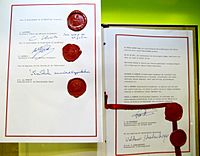Schengen Agreement facts for kids
| Agreement between the Governments of the States of the Benelux Economic Union, the Federal Republic of Germany and the French Republic on the gradual abolition of checks at their common borders | |
|---|---|

Signatures of the Schengen Agreement on 14 June 1985
|
|
| Signed | 14 June 1985 |
| Location | Schengen, Luxembourg |
| Effective | 26 March 1995 |
| Original signatories |
|
| Depositary | Government of the Grand Duchy of Luxembourg |
The Schengen Agreement is an important treaty. It led to the creation of the Schengen Area in Europe. In this area, countries mostly do not check passports or bags at their borders.
The agreement was signed on June 14, 1985. It happened near a small town called Schengen, Luxembourg. Five countries that were part of the European Economic Community signed it. These countries were Belgium, France, West Germany, Luxembourg, and the Netherlands.
The agreement aimed to slowly remove border checks between these countries. For example, cars could cross borders faster. People living near borders could cross more freely. The countries also agreed to have similar rules for visas.
What is the Schengen Area?
In 1990, another agreement called the Schengen Convention was added. This convention aimed to completely remove regular border checks inside the area. It also created a common visa policy. This means many countries use the same rules for who needs a visa to visit.
The Schengen Area works like one big country for international travel. When travelers enter or leave the area, they go through border checks. But once inside, there are no regular checks when moving between countries.
Today, the Schengen Area includes 26 European countries. Over 400 million people live in this area. It covers a huge space of about 4.3 million square kilometers.
How Schengen Became Part of the EU
At first, the Schengen agreements were separate from the European Union (EU). But in 1999, they became part of European Union law. This happened through a treaty called the Amsterdam Treaty.
Some EU countries, like Ireland and the United Kingdom, chose not to join the Schengen Area at that time. Now, Schengen is a key part of EU law. Most EU countries that are not yet in the Schengen Area must join when they meet the rules.
Several countries that are not part of the EU are also included in the Schengen Area. This allows for easier travel across many parts of Europe.
Images for kids
-
Schengen, a village in Luxembourg, where the agreement was signed
See also
 In Spanish: Acuerdo de Schengen para niños
In Spanish: Acuerdo de Schengen para niños


